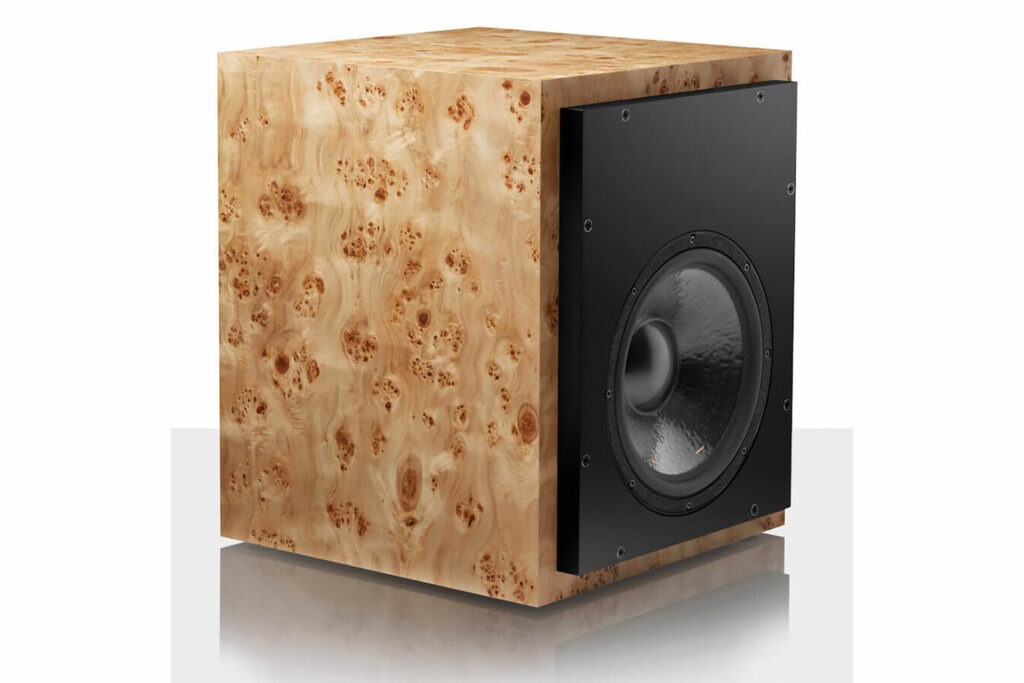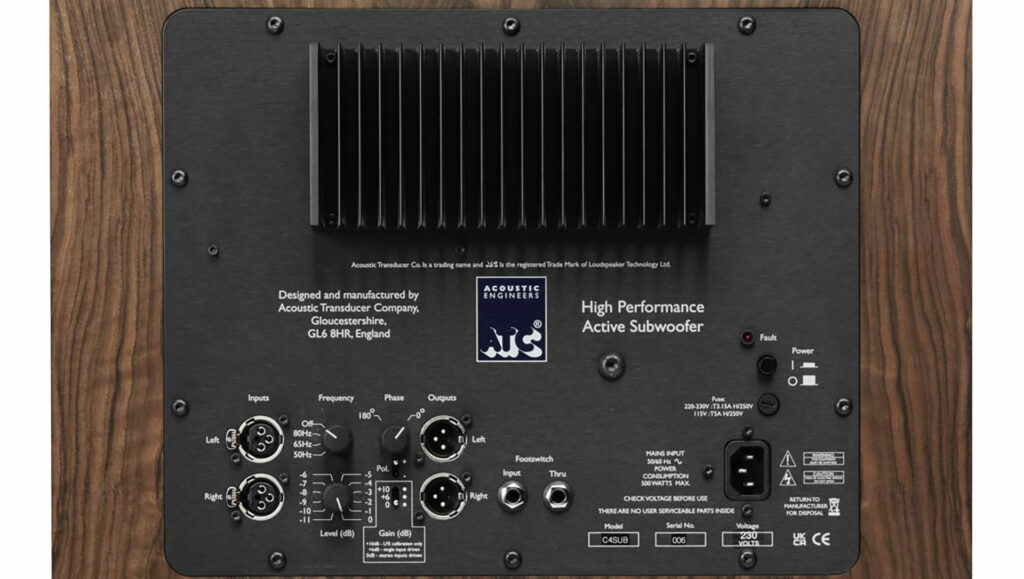World renowned for its signature high output, low-distortion audio engineering and trusted by musicians, studios, live sound engineers and audiophiles over five decades, The Acoustic Transducer Company (ATC) is proud to announce the production of the C4 Sub Mk 2 active subwoofer system. Designed to unite the highest standards of driver and electronics engineering in a single system, the C4 Sub Mk 2 deploys the all-new proprietary 12-inch SS75-314SC sub-bass driver, powered by a newly developed 300W class AB amplifier design, both elements hand-built and installed within a substantial cabinet at the company’s Stroud-based production HQ.

New ATC Sub-Bass Driver
The C4 Sub Mk 2 features the new SS75-314SC sub-bass driver, the first to be purpose-built for an ATC sub-bass system and developed by the R&D team to reproduce the lowest four octaves of the audio band. In order to achieve this the design exploits ATC’s signature long-gap/short-coil configuration to its natural limits with an exceptionally long 30mm magnetic gap, surrounded by a 6-inch/150mm N48M Neodymium magnet – the most powerful ever assembled by ATC and a first for the company. In support, the wholly redesigned motor system features a new rubber roll-surround for high excursion capability, a new spider for optimized compliance geometry, and high flow motor venting for low noise and compression.
As well as minimizing distortion, this unprecedented short-coil long-gap configuration ensures the voice coil remains within the motor structure – even at high drive levels – maximizing cooling, reducing power compression, and improving reliability. Turbulent air noise within the driver is minimized by a large, flared vent running through the center of the motor structure, which has the added benefit of increasing voice coil and motor cooling.Consequently, the C4 Sub Mk2 delivers an extended low-frequency response while avoiding electronic equalization, unlike many subwoofers available today. Instead, the more elegant combination of exceptional transducer engineering and a marginally larger cabinet volume is used. The simplicity of this approach reduces phase shift and group delay, aiding the integration of the sub with the partnering bookshelf loudspeakers.
New 300W ATC Amplifier
The all-new 300W class AB amplifier design is precisely optimized to the requirements of the new driver, resulting in fast, dynamic bass with minimal coloration. Two balanced line inputs provide connectivity for stereo or AV/home cinema systems while two balanced outputs are available to feed partnering ‘main’ stereo loudspeakers or to ‘daisy-chain’ multiple subs. Low-pass filters are analogue, 4th order Linkwitz-Riley, with filter frequency options ensuring optimal integration with partnering speakers. In addition, an industry-standard 80Hz low-pass filter and an ‘off’ option (for use with external processing) is joined by a polarity switch, variable 180° phase adjustment and a stepped attenuator over a 21 dB range for precise level matching.

The ATC C4 Sub Mk 2 Cabinet
Hand-built and finished at ATC’s cabinet factory and sharing styling with the brand’s ‘Classic’ and ‘Tower’ series loudspeakers, the C4 Sub Mk 2’s 70-liter cabinet employs 25mm/1-inch-thick panels and heavy bracing. It’s available in standard Cherry, Black Ash, Walnut and Oak real-wood veneers, as well as Satin Black and Satin White finishes, or in premium Rosewood, European Crown Cut Walnut, Burr Magnolia, and Pippy Oak real-wood veneers, with the option of high gloss over veneers and black/white piano lacquers also available.
Performance of the ATC C4 Sub MK 2
The size and performance of the C4 Sub Mk 2 make it a natural complement for ATC SCM19, SCM20, SCM40, SCM50 and SCM100 active/passive systems and high-performance loudspeakers of a similar size. Multiple subs can be employed to further elevate performance in larger rooms or when partnering larger loudspeakers. Buffered linkable inputs and outputs make connection of multiple subs easy.
Designed and engineered with a focus on resolution and integration, the C4 Sub Mk2 delivers a more balanced and coherent experience for the listener, extending the low-frequency response without masking details or changing the tonal character in the upper bass/lower mid-range. It provides an upgrade path to customers owning smaller loudspeakers and lacking space for larger stereo loudspeakers whilst also strengthening ATC’s options in AV applications.
Lone Mountain Audio Contact: Leland Leard • 1 (702) 755-5025
The History of ATC Speakers
ATC (Acoustic Transducer Company) is a British loudspeaker manufacturer founded in 1974 by Billy Woodman, an Australian-born engineer with a background in acoustic and mechanical design. From the beginning, ATC focused on designing loudspeakers for the professional audio market, specifically studio monitors that could deliver accurate, high-SPL performance for demanding recording environments.
The company’s first major innovation came in the form of the SM75-150s, a soft-dome midrange driver introduced in the mid-1970s. This 3-inch dome midrange unit became widely respected for its low distortion and natural reproduction of vocals and instruments. The driver remains in production today and is still used in several of ATC’s current speaker models, a testament to its longevity and performance.
During the late 1970s and early 1980s, ATC expanded its product offerings with the development of full-range studio monitors and active loudspeakers. Unlike traditional passive designs, active monitors from ATC featured built-in amplifiers tailored to each driver, allowing for better system integration and reduced distortion. The SCM50 and SCM100 became staples in studios around the world, offering extended dynamic range and accurate imaging. These models were available in both active and passive versions, depending on the application.
ATC’s reputation grew steadily in professional audio circles. Their monitors were adopted by major recording studios, mastering engineers, and artists. The company has supplied monitoring systems to facilities such as Abbey Road Studios, Skywalker Sound, and East West Studios. ATC monitors have been used in the production of albums across genres, from classical and jazz to rock and pop.
In the 1990s, ATC began developing products for the consumer hi-fi market, adapting their studio technology for home use. These models retained the company’s core engineering principles—such as sealed-box enclosures, high-performance drivers, and active amplification in select models—while offering industrial design suitable for domestic environments. The SCM series, particularly models like the SCM19, SCM40, and SCM100, became popular among audiophiles looking for a neutral, revealing loudspeaker.
ATC manufactures nearly all of its components in-house, including drivers, crossover networks, and amplifiers. The company’s vertically integrated approach allows for tight quality control and consistency across its product range. Its in-house amplifiers use discrete MOSFET designs and are engineered specifically to match the performance characteristics of their drivers.
In addition to loudspeakers, ATC also produces standalone electronic components such as preamplifiers, power amplifiers, and CD players, though its primary identity remains centered around loudspeaker manufacturing.
Today, ATC continues to serve both the professional and consumer audio markets. Its speaker systems are known for their durability, accuracy, and consistency, with a product range that includes compact nearfield monitors, large-format main monitors, and floorstanding consumer loudspeakers. The company remains privately owned and headquartered in Stroud, Gloucestershire, England, with all manufacturing and R&D conducted on-site.
ATC maintains a reputation for engineering-focused design with minimal emphasis on marketing trends. Its products are typically found through specialty dealers and studio suppliers rather than mass retail, reflecting its focus on performance and reliability over brand visibility.



